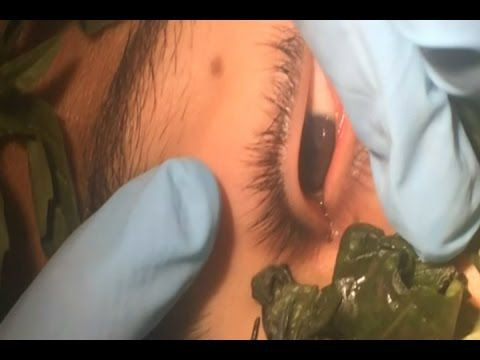Doctors Use Basil Leaves To Remove Suspected Botfly Larvae From Boy's Left Eye After A Month

A visit to the doctor for a swollen eye evolved into something much more horrific after a teen in Peru underwent an MRI. Doctors at the Children’s Hospital in Lima were surprised to discover the 17-year-old from Pozuzo had a 3-centimeter worm living in his left eye for a month. The teen was suspected of having a botfly larva in his eye, which doctors promptly chose to remove with basil leaves and tweezers.
In the horrific video, ophthalmologist Dr. Carolina Marchena and her assistants can be seen using a bunch of basil leaves to lure the creature out of the boy’s eye, since it's attracted to the smell. Marchena holds the herb close to the boy’s tear duct and then proceeds to pull it out with tweezers. "…[B]ecause of the size of the worm, it was impossible for it to come out completely on its own. It just stuck a little part out, which was its head," Marchena said of why she used tweezers.
The worm is likely a mosquito of the species Dermatobia hominis, also known as a human botfly. These botflies use 40 different species of mosquitos and other insects as a way to infect humans. The fly captures the vector, deposits the eggs onto it, and releases it. When the mosquito bites a human to feed, the eggs are then dropped into the skin. According to the University of Florida’s Entomology & Nematology department, it is the body heat that causes the eggs to hatch as they burrow under the skin, leading to larvae developing in the next eight weeks.
Larvae can develop wherever the eggs lay, which in the boy’s case was the eye. Although botflies do not cause long-term harm for their hosts, Marchena and the doctors were afraid it could spread infection to the brain due to its proximity. "The location of the worm from the lower lid, which was getting bigger, increased the risks, because the youth's tissue was swelling in an area close to the sinuses that's near the face's delicate triangle of death," she said.
Recently, a woman who suffered from a severe lip swelling learned it was from a botfly. In the YouTube video, doctors suspect one entered her lip and laid eggs. As the eggs began to grow inside, the woman’s lip slowly began to swell. The doctor successfully removed the larvae with surgical tools, which was about 3 centimeters in length.
Luckily, the Peruvian teen and the woman didn’t suffer any long-term effects of the larvae.



























